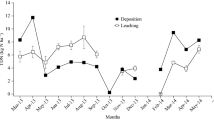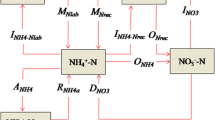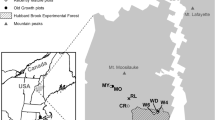Abstract
We examined patterns of N retention in the coastal forests of the Waquoit Bay watershed on Cape Cod, Masschusetts using 15N tracer techniques. A solution of 99.6% enriched 15N -NO3 −, at a concentration similar to that of background throughfall, was applied to forest plots established along a gradient of soil texture to simulate and track the fate of throughfall NO3 − deposition. The tracer solution was applied to replicate plots during both the spring and fall to examine seasonal differences in ecosystem retention. 15N enrichment was subsequently measured in litter, O2 horizon, 0–15 cm mineral soil, fine roots, microbial biomass in the O2 horizon and mineral soil, and lysimeter leachate over a 6 month period following each application. The O2 horizon contained the largest fraction of 15N in all sites immediately following the spring application (19–45%) but was less important following the fall application (10–25%). The mineral soil N pool generally contained the largest fraction of applied 15N (7–28%) in all sites at the end of both 6-month sampling periods. Microbial uptake of applied 15N provided an initial barrier against leaching loss as well as a mechanism for its long-term incorporation into soil organic matter. Microbial processing was less important in the most coarsely textured site, perhaps as a result of lower substrate availability and smaller microbial pool sizes. The highest cumulative leaching losses of applied 15N were observed in the coarse sand site (40, 51%) followed by the fine sand (13, 43%) and loamy sand (4, 19%) sites for the spring and fall applications, respectively. More than 90% of all 15N captured in lysimeters occurred within two days following the applications, and 25–43% of all 15N captured in lysimeters after 2 days was in the form of dissolved organic nitrogen (DON) indicating that it had been assimilated by microbes prior to leaching.
Similar content being viewed by others
Author information
Authors and Affiliations
Additional information
Received: 3 February 1997 / Accepted:10 June 1997
Rights and permissions
About this article
Cite this article
Seely, B., Lajtha, K. Application of a 15N tracer to simulate and track the fate of atmospherically deposited N in the coastal forests of the Waquoit Bay Watershed, Cape Cod, Massachusetts. Oecologia 112, 393–402 (1997). https://doi.org/10.1007/s004420050325
Issue Date:
DOI: https://doi.org/10.1007/s004420050325




